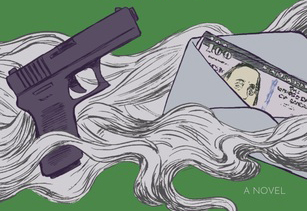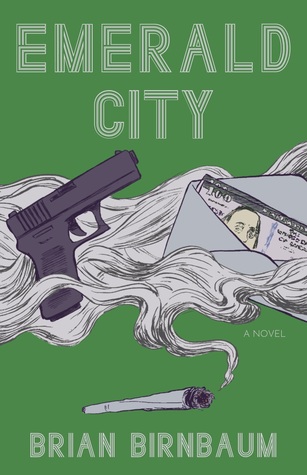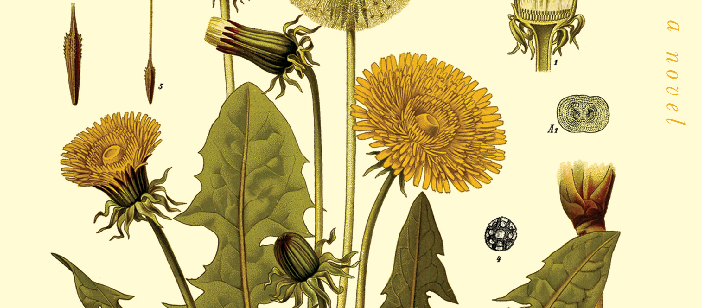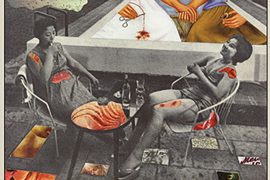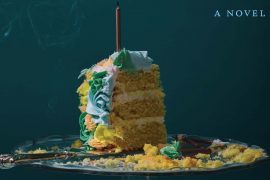Welcome to another installment of If My Book, the Monkeybicyclefeature in which authors shed light on their recently released books by comparing them to weird things. This week Brian Birnbaum writes about Emerald City, his debut novel just published by Dead Rabbits Books.
If Emerald City were a profession, it would be a psychoanalyst treating a dubious patient.
“[Finnegan] O’Reilly jotted. Peter gazed about the room, at potted plants, stills of construction sites, beach portraits. Bob Ross aesthetic, with a clinician’s sanitary touch.
It struck him: why should he sit here talking in circles with this man who sold psychological schlock that, among several other sick notions, maintained all men wanted to fuck their mothers? Why couldn’t Peter go piss in the plastic cup waiting for him in the bathroom, have O’Reilly sign off on their session, and cease this charade brought on them both by some asshole in black robes to whom standardized education and jurisprudential connections had come easy enough that he’d been deemed an arbiter of justice? Peter was going to die someday. That day could’ve come last winter, when he’d almost killed himself with his bike, which made him nearly responsible for doing to himself the thing that he, and most reasonable humans, fear most. That shit like this could simply happen was inescapable. Acknowledging this didn’t make him crazy, didn’t make him depressed. He was probably more mentally aligned than O’Reilly, who, dimly aware that he’d one day cease to be, still spoke and moved with the urgency of a plant. Put simply, O’Reilly couldn’t counsel Peter out of a box.”
If Emerald City were a person, it would be Carl Jung.
Carl Jung practiced shadow work, which investigated the repressed personalities of his patients (or people), repressed material that’s largely negative in nature. Emerald City’s structured such that, after Part I, where we get a lay of the plot, Part II rewinds back to the major characters’ pasts, revealing experiences that, short of explaining for, lend reference to why these people are the way they are—or, more bluntly, why and how people can turn into the long shadows of their potential.
“It starts with [Benison] playing like shit. Then he plays like shit becausehe’s been playing like shit—a self-generating shit-mechanism, being shat on by his opponents, stinking up and down the floor and throwing the shit he’s covered in, petulantly flinging it everywhere, on everyone. And now the negative capability required of him as an athlete—of forgetting himself—is exposed to assumptions that he will fail. Now he considers his moves on the hardcourt in the way that thinking about thinking can paralyze genius. Then he hesitates. It turns his fluid jump shot into a stilted aim at the basket. His basketball IQ is double-thoughted and therefore dumbed. Failure to play extrapolates unto a more insidious failure to performin general, worsening his failure to play, a closed loop of provenance of a piece with the cosmos and all things fated.And up goes the Gatorade jug, or the video game console…”
If Emerald City were a psychological experiment, it would be the Milgram shock experiments meets MK-Ultra.
Simply put, a day in the park with Julia and Peter—on mushrooms:
“Lurid flowers exploded from the late-spring green. The basketball court’s bitumen looked like Oreo cheesecake. Peter’s aura pumped and pulsed in ineffable rhythm. But then he checked the ball, setting in motion the grunt and flurry of physical competition, and all the warm colors melded into mud. Peter, so far now. His laugh, once childlike, now complicit, almost diabolical. The pharmacists at the picnic table looked at her sidelong, whispering. Cars screamed by Denny and Westlakelike imperial TIE fighters. The girl pacing the park’s border, still on her phone, could only have been relaying Julia’s position to a savage capo coordinating this two-front offensive against her granddad—all of which distracted her from the two burly ruds busting onto the scene, one sporting an oily mullet and ripped jean shorts, the other a torn blue tank bearing splotchy bandoliers of white paint as if this blanched X signaled rejection of the paunch protecting his essential organs. (rədn. Peterism: a red-faced alcoholic contracted to perform undesirable or illicit work.) The two ruds muscled their way into the game, which beckoned Julia’s paranoid attention, demanding that all spectators and the otherwise sidelined enjoin the fray. Julia shrunk into the crosshatched fence, praying that she’d become part of its backdrop. The mulleted rud’s glare locked her in, along with the iridescent bruise spread from his right eye back to temple. Her heart shriveled into a knot and remained roped up like that as the mulleted rud turned to the girl on the phone and seemed to glean sordid joy from her presence. Just then the other rud ripped the ball from Peter and hurled it across the court. A sharp exchange, and Julia went rigid as the mulleted rud threatened those who dared budge a muscle. She saw his partner bear down on the park’s gate, his tank’s messy X like a target homing in on its projectile, something terrifyingly obverse, which triggered in Julia a surge of paranoia indistinguishable from that of the weeks prior to finding Peter at Lissener’s Halloween party—how, in trying to find him, it felt as if, at any moment, she’d be swept up in burlap and tossed in a white van, and now this was actually happening.’Shroom-delusions didn’t come in high-definition. Stricken, she watched the smaller rud steal the girl mid-phone call and haul her out of the park, his mulleted partner backpedaling in his wake, guarding the gate, firearm brandished in broad daylight. The girl struggled against the rud’s homegrown arms, hooked under her armpits, dragging her like carry-on luggage, her feet its broken wheels, grinding along the pavement. He forced a roll of yarn in her mouth, slapped her for refusing the roll, made her clamp on it. His accomplice kept watch by the entrance, his piece trained on anyone who’d move a fucking muscle. Near the van’s rear, the smaller rud taped the makeshift bit, mummifying her mouth, and shuttled the girl through the drab conversion van’s opened hatch.”
If Emerald City were a drug, it would be a mirage.
In a book utterly saturated with drug use and addiction, the last line pretty much says it all.
But more than that, in a book teeming with unsavory characters of all stripes, the three protagonists—or, perhaps, one protagonist (Julia), a main character (Benison), and an antihero (Peter)—are no different than those of other ‘demographics’, be them Deaf, black, homeless, etc. We are all chasing something, and driven by, something that isn’t really there. We are a set of impulses—a literal data set, if you ask Cambridge Analytica—predicated upon chemical codes that are galvanized by chemical reactions.
If we live as if this is all there is, the logical terminus is nihilism, for nothing in this world—be it drugs, sex, food, etc.—will satisfy us. Only matters of the spirit can fill us up, which we tap into through our care and concern for others, and the world around us. The mirage is the American Dream, the idea of self-fulfillment/-actualization through material means, which deludes us. The only real solution is other people, without whom we’d be useless. Some of my characters use people to feed their addiction, whether through corporate fraud or sexual predation. Some of them destroy themselves, never knowing or accepting the simple fact that they were victims of these crimes, the detritus of others’ delusions. Few of them make it out healthy, and still less with hope. Making it more Darren Aronofsky than Christopher Nolan.
If Emerald City were a movie, it would be Requiem for a Dream directed by Quentin Tarantino with the treatment done by Derek Cianfrance.
There’s one scene in particular that espouses these three directors.
Peter, a wunderkind drug mule, is hired by a deranged kingpin to run across the Canadian border an arcane flora used in ancient mystical rituals. During a particular run he crashes his bike into a gaggle of bud-bags—duffels stuffed with marijuana—and finds himself embrangled in a sordid situation: a gang of fake Canadian cops having ambushed a squad of real Canadian cops, who’d just busted a mule, for their loot.
The mirage—the dream—is the flora, antinomine—and everything that surrounds it: the kingpin’s belief in its mystical properties; Peter’s belief in money and thrill’s ability to save him.
The Tarantino is the dialogue. After being waylaid by the gang, Peter’s asked about what’s in the satchel he’s running:
“Antinomíne,” Peter started. “Central American plant embargoed in the States. It’s nothing, some Guatemalan nostrum, but this old rich guy outside Bellingham thinks it’s God’s gift. Must have cancer or something.”
“The fuck is a nostrum?” his captor grumbled.
“Think it’s that plant everyone’s been hyping these days,” another fake Mountie quipped, unwinking eye trained along the barrel, his prey’s glare unwavering. “Think it’s weed they’re calling it, eh? Pot. Bud. Mary Jane. Plenty o’ names for you to choose from once you quit shitting us around.”
“It’s like you said,” Peter doubled down. “Would I really be running for—what would this be?—ounces?”
“He said pounds. Two pounds,” his captor insisted. “And if Liam says your fag-sack fits two pounds, it fits two fuckin pounds.”
The leader—Liam—studied him for answers veiled by his responses. Peter mirrored his gaze, abdomen tightening around the blow to his stomach.
“I’d show you my burner if it didn’t get busted when I crashed.”
“Bullshit,” claimed his captor. “He was breaking it on a rock when I showed up.”
“Oh the satchel’s worth a pretty penny. This much is obvious,” said Liam. “But whether it’s worth our while…”
As for Cianfrance, he directed Into the Pines, and being that Peter’s muling across the Canadian border, and that the novel’s set in Seattle…
If Emerald City were a parable, it would be Siddhartha, as treated by Martin Scorsese.
This one ties it together. Emerald City isn’t just a crime novel. As goes its blurb from Gabe Habash, “Though this nimble and virtuosic novel tracks everything from the long shadow of addiction to the unique pressures of college athletics, Emerald Cityis, at its heart, an intensely moving story about family…” More than a crime novel, it’s a story about seeing past the mirage of the material world, and into what connects us. Family is one thing, but it’s also a stand-in for connection in general, for people, for the only thing that can truly sustain us.
But it’s also a crime novel—an organized crime novel. Hence the Scorsese.
Brian Birnbaum grew up thirty minutes west of Camden Yards in Baltimore, where at four years old he cried because the Yankees were losing. An MFA graduate of Sarah Lawrence College, his work has been published or is forthcoming in The Smart Set, The Collagist, Atticus Review, SLAM Magazine, Lit Hub, Political Animal, and more. Emerald City is his first novel. Brian is a child of Deaf adults (CODA) and works in development for the family sign language interpreting business. He lives in Harlem with the writer M.K. Rainey and their dog. Follow him on Twitter at @BrianBurnbomb.

